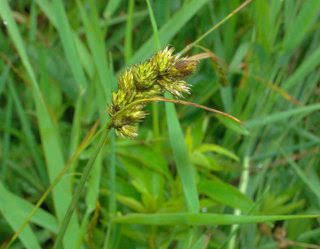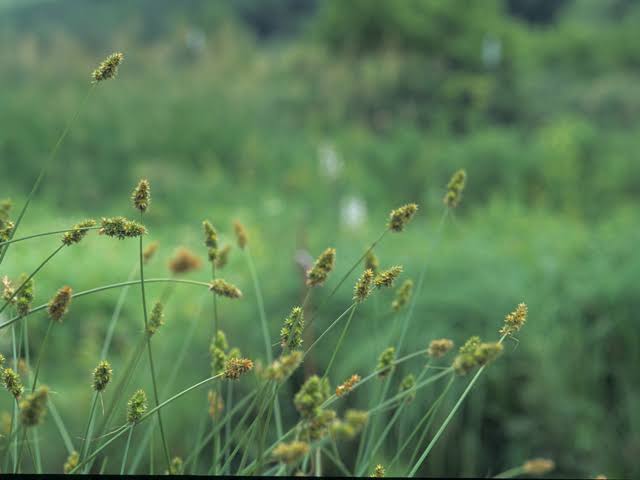Wiegand’s sedge (Carex wiegandii) is a fascinating plant that captivates with its unique characteristics. This sedge, named after the American botanist Karl McKay Wiegand, is a perennial grass-like species that belongs to the Carex genus.
In terms of appearance, Wiegand’s sedge typically grows in dense clumps, featuring slender, arching leaves that can reach impressive lengths. The leaves, which are often green with hints of brown, add an ornamental touch to natural landscapes. Its inflorescence takes the form of inconspicuous flower spikes, contributing to the plant’s understated beauty.
Native to certain regions of North America, Wiegand’s sedge has adapted to various ecosystems, showcasing its versatility. This adaptability allows it to thrive in diverse habitats, from moist meadows to wooded areas. The plant’s ability to tolerate different conditions makes it a resilient and valuable component of local ecosystems.
Ecologically, Wiegand’s sedge plays a crucial role in supporting biodiversity. Its dense clumps provide shelter and nesting sites for small animals and birds. Additionally, the plant’s roots help prevent soil erosion, contributing to the stability of its habitat.
Cultivating Wiegand’s sedge is relatively straightforward, as it can be grown in a variety of soils. This makes it a popular choice for landscaping projects, adding a touch of natural elegance to gardens and green spaces. Gardeners appreciate its low maintenance requirements and the visual interest it brings to their outdoor environments.
In addition, Wiegand’s sedge stands out as a remarkable plant, showcasing both aesthetic appeal and ecological significance. Its adaptability, resilience, and contribution to biodiversity make it a valuable asset in various natural settings and a charming addition to cultivated landscapes.
Read Also: Honey Bees: A Closer Look
How To Grow Wiegand’s Sedge (Carex wiegandii)

Growing Wiegand’s sedge (Carex wiegandii) can be a rewarding experience, especially for those looking to enhance their gardens with this unique and adaptable plant. Here’s a simple guide on how to grow Wiegand’s sedge:
1. Select the Right Location: Choose a location that provides the right growing conditions for Wiegand’s sedge. It generally thrives in well-drained soil and can tolerate various light conditions, from full sun to partial shade.
2. Planting Time: Plant Wiegand’s sedge in the spring or fall when the soil is workable and temperatures are moderate. This allows the plant to establish itself before extreme weather conditions.
3. Soil Preparation: Prepare the soil by loosening it to a depth of a few inches. Wiegand’s sedge is adaptable to different soil types but prefers a slightly acidic to neutral pH.
4. Planting Depth: Plant the sedge at a depth that allows the crown to be at or slightly below the soil surface. Water the plant thoroughly after planting to help it settle into its new environment.
5. Watering: Keep the soil consistently moist, especially during the initial stages of growth. While Wiegand’s sedge can tolerate some drought, regular watering promotes healthier and more vibrant foliage.
6. Mulching: Applying a layer of mulch around the base of the plant helps retain soil moisture, suppress weeds, and regulate soil temperature. Mulching is particularly beneficial in dry or hot climates.
7. Pruning: Trim back any damaged or dead foliage as needed. This not only improves the plant’s appearance but also encourages new growth. Wiegand’s sedge generally requires minimal pruning.
8. Fertilization: Fertilize sparingly, as excessive nutrients can lead to leggy growth. A balanced, slow-release fertilizer in spring should be sufficient for promoting healthy growth.
9. Division: If the plant becomes overcrowded or outgrows its space, consider dividing it. This can be done in early spring or fall, and it helps rejuvenate the plant while providing additional specimens for other areas.
10. Winter Care: Wiegand’s sedge is generally hardy, but in colder climates, a layer of mulch can provide added protection during winter. Be mindful of extreme temperature fluctuations.
By following these simple steps, you can successfully cultivate Wiegand’s sedge and enjoy its aesthetic appeal in your garden or landscape.
How To Care For Wiegand’s Sedge (Carex wiegandii)
Caring for Wiegand’s sedge (Carex wiegandii) involves some straightforward practices to ensure its health and vitality. Here’s a guide on how to care for Wiegand’s sedge:
1. Watering: Keep the soil consistently moist, especially during dry spells. While Wiegand’s sedge is somewhat drought-tolerant, regular watering promotes lush and vibrant foliage. Ensure proper drainage to prevent waterlogging.
2. Sunlight: Wiegand’s sedge is adaptable to different light conditions but generally prefers partial shade. However, it can also tolerate full sun. Monitor the plant’s response to light and adjust its location if needed.
3. Soil Conditions: Plant Wiegand’s sedge in well-drained soil. While it can adapt to various soil types, it thrives in slightly acidic to neutral pH. Regularly check the soil’s moisture levels and amend it if necessary to maintain optimal growing conditions.
4. Mulching: Apply a layer of mulch around the base of the plant to conserve soil moisture, suppress weeds, and regulate soil temperature. Mulching is particularly beneficial in areas with hot or dry climates.
5. Pruning: Trim back any damaged or dead foliage as needed. Pruning not only improves the plant’s appearance but also stimulates new growth. Wiegand’s sedge typically requires minimal pruning, but occasional maintenance can enhance its overall health.
6. Fertilization: Fertilize sparingly, as Wiegand’s sedge doesn’t require excessive nutrients. A balanced, slow-release fertilizer applied in spring should be sufficient to support healthy growth. Avoid over-fertilizing to prevent leggy or weak stems.
7. Division: Periodically divide the plant if it becomes overcrowded or starts to decline in vigor. This can be done in early spring or fall. Division helps rejuvenate the sedge, promoting better growth and maintaining its overall health.
8. Winter Care: While Wiegand’s sedge is generally hardy, providing a layer of mulch around the base can offer additional protection during colder months. This is particularly important in regions with harsh winter conditions.
9. Pest and Disease Management: Monitor the plant for any signs of pests or diseases. If detected, address the issue promptly using appropriate measures, such as insecticidal soap for pests or fungicides for diseases.
By following these care guidelines, you can ensure that Wiegand’s sedge thrives in its environment, contributing to a healthy and visually appealing landscape.
Read Also: How Do Honey Bees Reproduce
The Uses of Wiegand’s Sedge (Carex wiegandii)

Wiegand’s sedge (Carex wiegandii) offers several uses, both in natural ecosystems and cultivated landscapes. Here are some notable applications:
1. Ornamental Landscaping: Wiegand’s sedge is commonly used in ornamental landscaping for its attractive, arching foliage. Its graceful appearance adds a touch of elegance to gardens, borders, and other landscaped areas.
2. Soil Erosion Control: The extensive root system of Wiegand’s sedge aids in preventing soil erosion. When planted in areas prone to erosion, such as slopes or near water bodies, the sedge helps stabilize the soil, reducing the risk of runoff.
3. Wildlife Habitat: The dense clumps of Wiegand’s sedge provide shelter and nesting sites for small animals and birds. Its presence in natural ecosystems contributes to biodiversity by supporting various wildlife species.
4. Wetland Restoration: Given its adaptability to moist conditions, Wiegand’s sedge is often used in wetland restoration projects. Its ability to thrive in wetter environments makes it a valuable component in re-establishing or enhancing natural wetland ecosystems.
5. Groundcover: As a spreading plant, Wiegand’s sedge can be utilized as a groundcover in areas where low maintenance and soil coverage are desired. It forms dense clumps that suppress weeds and create a visually appealing carpet of foliage.
6. Rain Gardens: Wiegand’s sedge is suitable for rain gardens and biofiltration systems. Its tolerance to varying moisture levels makes it an excellent choice for these environmentally friendly solutions designed to manage stormwater runoff.
7. Restoration of Disturbed Sites: The adaptability of Wiegand’s sedge makes it a valuable species for restoring disturbed sites, such as construction areas or areas recovering from human impact. Its presence aids in the natural regeneration of vegetation.
8. Educational and Research Purposes: Wiegand’s sedge is of interest to botanists, ecologists, and researchers studying plant adaptation and ecological restoration. It serves as a subject for educational purposes and contributes to the understanding of plant dynamics in different ecosystems.
9. Soil Improvement: The plant’s root system enhances soil structure and promotes microbial activity, contributing to overall soil health. This makes Wiegand’s sedge beneficial in soil improvement initiatives.
By understanding and leveraging these uses, individuals and conservationists can maximize the ecological and aesthetic benefits of Wiegand’s sedge in various settings.
Frequently Asked Questions (FAQs)
Q: What is Wiegand’s sedge (Carex wiegandii)?
A: Wiegand’s sedge, scientifically known as Carex wiegandii, is a perennial grass-like plant named after the American botanist Karl McKay Wiegand. It is characterized by slender, arching leaves and inconspicuous flower spikes.
Q: Where is Wiegand’s sedge native to?
A: Wiegand’s sedge is native to certain regions of North America. It has adapted to various ecosystems and can be found in habitats ranging from moist meadows to wooded areas.
Q: How do I grow Wiegand’s sedge in my garden?
A: To grow Wiegand’s sedge, choose a well-drained location with varying light conditions (full sun to partial shade). Plant it in spring or fall, ensuring the crown is at or slightly below the soil surface. Keep the soil consistently moist, and consider mulching for moisture retention.
Q: Is Wiegand’s sedge suitable for landscaping?
A: Yes, Wiegand’s sedge is commonly used in ornamental landscaping for its aesthetic appeal. Its graceful foliage adds elegance to gardens, borders, and other landscaped areas.
Q: How do I care for Wiegand’s sedge?
A: Care for Wiegand’s sedge by providing consistent moisture, choosing the right sunlight conditions, and ensuring well-drained soil. Mulching, occasional pruning, and division when necessary contribute to its overall health. Fertilize sparingly and protect it during extreme weather conditions.
Q: Can Wiegand’s sedge tolerate drought?
A: While Wiegand’s sedge is somewhat drought-tolerant, regular watering is recommended to promote healthy and vibrant growth. It’s adaptable to various soil conditions but benefits from consistent moisture.
Q: What is the role of Wiegand’s sedge in ecosystems?
A: Wiegand’s sedge plays a crucial role in supporting biodiversity by providing shelter and nesting sites for small animals and birds. Its dense clumps contribute to soil stability, preventing erosion.
Q: Can Wiegand’s sedge be used for soil erosion control?
A: Yes, Wiegand’s sedge is effective in controlling soil erosion due to its extensive root system. Planting it in areas prone to erosion, such as slopes or near water bodies, helps stabilize the soil.
Q: Is Wiegand’s sedge suitable for wetland restoration?
A: Yes, Wiegand’s sedge is often used in wetland restoration projects. Its adaptability to moist conditions makes it a valuable component in re-establishing or enhancing natural wetland ecosystems.
Q: How can Wiegand’s sedge be utilized in rain gardens?
A: Wiegand’s sedge is suitable for rain gardens and biofiltration systems due to its tolerance to varying moisture levels. It helps manage stormwater runoff in environmentally friendly solutions.
Read Also: How to Choose the Right Trash Service for Your Needs
